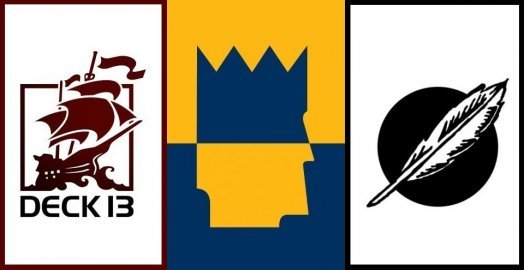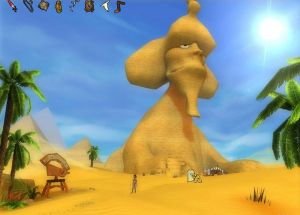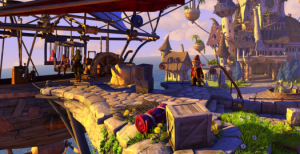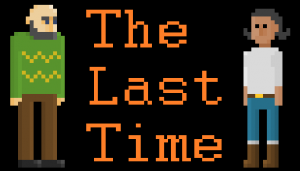Adventures in Germany and Beyond round table (Part 1) interview

"These days it seems like adventure games are almost a bit of a lost art form...they exist in our dreams, in our memories and... in Germany."
While this statement by Tim Schafer back in 2012 might be slightly exaggerated, there is no doubting the importance of Germany when it comes to the “adventure renaissance” of the last decade-plus. While the genre was reduced mainly to small indie studios throughout many parts of the world, German developers continued to produce high-quality and relatively large-budget games reminiscent of the Golden Era.
Lately, however, it appears that even Germany isn’t immune to changing and challenging market forces. The video game industry has continued to evolve, including the way games are being sold and consumed, and adventure game designers have had to adapt right along with it. Companies like Deck13, KING Art, and Daedalic have all experienced these developments up-close, so the time seemed right to invite each studio’s creative director to a lengthy Skype conversation.
Our first attempt was unfortunately impaired by technical issues, but thankfully Jan “Poki” Müller-Michaelis (Daedalic Entertainment), Jan Theysen (KING Art), and Jan Klose (Deck13) agreed to take part once again, and the extra effort was certainly worthwhile. Over the course of nearly two hours, we discussed the state of adventure games in Germany and beyond in such detail that we’ve decided to split the transcribed talk into two parts, each containing many insights from a developer’s perspective, plus lots of juicy anecdotes. Enjoy reading on as Jan, Jan, Jan (we'll help you keep track!) and I not only discuss our native country’s history with adventure games, but also dissect the general outlook and evolution of the genre.
Ingmar Böke: Thanks a lot for taking the time for this discussion. Please introduce yourselves briefly and tell us how you turned from adventure game fans into adventure game developers.
Jan Klose: I’m Jan Klose, creative director and co-founder of Deck13. We started out developing several adventure games, and the reason is that I really enjoyed playing adventure games myself – adventure games and role-playing games, to be precise. In elementary school I had a friend with an Apple II computer, and it was a fascinating experience to watch him play Maniac Mansion. I was particularly intrigued by the adventure games from LucasArts, which felt a bit like a movie with loads of humor. At some point you start thinking to yourself, “well, creating something like this seems doable,” and so we started developing our first adventure game many, many years ago. That game was Ankh.
Poki: In the broadest sense, I also ended up in the industry because of my love for adventure games. Eleven years ago, I co-founded Daedalic Entertainment as creative director. Just like Jan, I played plenty of adventures in my youth, and got really sad when they vanished. I was educated in media technology at the Hamburg University of Applied Sciences. That’s a pretty broad kind of study program, and for quite some time I wasn’t sure what I would end up doing. What I did know was that I preferably wanted to tell stories in some way; that was always the driving thing for me. At the time, I didn’t have a particular kind of platform in mind. However, because of my own experiences as a player I knew that it was possible to tell great stories with computer games.
I studied for a long, long time – for 16 semesters, to be precise. (laughs) Parallel to my studies, I worked on all kinds of projects in various types of media. I did short movies, recorded an album, did freelance work as a web designer, and did a lot of graphic work during that time. Actually, I moved away further and further from computer games. However, at some point I said to myself, “oh my god, I really have to wrap up my studies!” The shortest way of getting there was a module called “computer-generated media”. To motivate myself for my diploma thesis, I chose a subject matter that I was passionate about, and that was storytelling in a computer-generated media. From there, it wasn’t a long way to the adventure games I used to love playing and started missing at some point. The subject of my diploma thesis was “computer games as a non-linear storytelling device” … or something like that. (laughs)
For the practical part of my thesis, I started development on my own game. By the time I had to hand in my thesis, one version of the game was playable from start to finish. That game was Edna & Harvey: The Breakout. During my thesis colloquium, I got to know Carsten Fichtelmann, who was the marketing director of Hamburg-based publisher dtp at the time. One week later, he called me up and asked me if I would like to stop by at dtp. I did, and a half-year later, both of us quit our jobs and founded Daedalic Entertainment together.
 |
Poki accepts the Best Story award for Harvey's New Eyes at the 2012 German Developer Awards |
Edna & Harvey: The Breakout actually ended up being the first game that we published at Daedalic. A New Beginning was the first game at the company that we started fleshing out from scratch. I also did Harvey’s New Eyes, a sequel to Edna & Harvey: The Breakout, four Deponia games, and a few other projects in between. Like, I also did a lot of work on The Whispered World. (contemplates) Hmm, I nearly forgot one particular adventure game. As contract work, we did a game for a German movie with [German actor] Til Schweiger, 1 ½ Knights. It was an awful film! [collective laughter] The game was great, though!
Jan Theysen: I‘m Jan Theysen, creative director at KING Art. I remember that the first adventure game I ever saw was Zak McKracken on my brother’s Amiga 500. I also remember that I couldn’t stand it. (laughs) Why on earth would someone put an egg into a microwave on a plane and all that kind of stuff? I just couldn’t relate to any of that and didn’t like it. (laughs) About a year later, though, I played Monkey Island on PC, and this game not only convinced me of adventure games being a good thing, but also computer games in general.
My old friend – and today’s business partner – Marc [König] and I then played all of the classic LucasArts games and said, “hey, that’s what we’re going to do!” At 10, 11, 12 years old we started dealing with how to develop computer and adventure games and started working on a Star Wars game and an Indiana Jones game. Of course we never finished them, and even if we had, we surely would have gotten into quite a bit of legal trouble. (laughs) Yet we knew that we would like to work in computer games at some point, and adventure games always were an important reason for that. When we founded KING Art, we said to ourselves, “alright, what do we start with?”, and felt like point-and-click adventure games could be a good genre for us to come up with something good.
Then we started pitching our first adventure, The Book of Unwritten Tales, and dtp asked us if we would like to do Black Mirror 2 instead. They really liked our pitch for The Book of Unwritten Tales but were toying around with a new Black Mirror game at the time. We created the story, concepts, etc. for them, so this was just the preproduction. When Black Mirror 2 ended up being continued internally, we did The Book of Unwritten Tales instead. Afterwards, we did a sequel called The Critter Chronicles, a whodunit adventure called The Raven, and The Book of Unwritten Tales 2.
We always liked doing adventure games, and we would like to continue doing so, but for now we’re not developing games in this genre – which is surely going to be discussed at a later point – as it’s gotten harder and harder to create high-quality adventures that sell enough copies to justify their production.
Ingmar: How do you evaluate the demise of adventure games in the second half of the 1990s?
 |
Business partners Marc König and Jan Theysen are childhood friends who grew up hoping to design adventure games |
Jan Theysen: I think the main aspect at the time was that adventures used to be the AAA games of their time. They used to be cutting-edge in terms of their visuals, and perhaps the games that impressed a lot of people the most. At some point they lost that kind of status, and there were other games that looked different or that were bigger and more complex. There was this kind of thinking in the mainstream that adventure games are a thing of the past, and that there are newer, cooler, and better games. Also, the effort that was needed to make good adventure games increased, and at some point the ratio between effort and income diverged. Fewer people bought adventure games while their production got more expensive, and I think that resulted in a lot of developers and publishers focusing on other games that were more likely going to make a profit.
Jan Klose: The aspect of increased costs actually comes from a different direction, I think. I definitely agree with Jan about adventure games being the highlight back in those days. Whoever saw The Secret of Monkey Island or Indiana Jones and the Fate of Atlantis on Amiga or PC back then saw some of the visually most impressive games out there. These games had great audio, neat cut-scenes, close-ups on characters… all of that looked really, really awesome!
When 3D graphics became the hot new thing during the late ‘90s, it became difficult for adventure games to hold up. You know, adventure games were particularly about stories and characters, and the characters’ facial expressions were really important. The genre had found a pretty cool visual style with low resolution pixels, and it was possible to get emotions out of the smallest pixels, but now you had these new 3D graphics where you could only bring a few odd polygons to the screen. Perhaps you could use that approach to come up with some nice spacecrafts or a level for a game like Doom – even if that particular game wasn’t using “real 3D”. But it wasn’t possible to do much more, especially when it came to characters, so the cool games with impressive visuals were 3D games, but 3D adventures just didn’t work – no matter how much effort you’d put into a game. This was the time when a new way of adventure presentation had to be found.
The first adventures that tried as computers got more efficient – I think Simon the Sorcerer 3D was one of the first – they looked awful, and nothing of the vitality and emotions of the characters was left. Perhaps this scared even more people away from the genre, leading them to say: “I never want to touch one of these things again!” I think there is a reason why the first adventures re-appeared around 2004, 2005 – at a time when we started with Ankh – because by then it was possible for a computer to illustrate good-looking 3D characters, and there was also 2.5D, something like pre-rendered backgrounds along with 3D character models. Suddenly, it was possible to make characters look lively and cool again, and I think that was one important reason.
 |
Deck13 co-founders Florian Stadlbauer and Jan Klose doing what German developers (allegedly) do when not making games |
In the beginning, adventure games were awesome for players, and people bought computers to play Monkey Island or Indiana Jones. Later on, they bought computers so they could play Doom, Quake, and Duke Nukem, and adventures stopped being hot. I think the time in between [the golden era of adventure games and the genre’s renaissance] might have been the worst ever for adventure games and storytelling in games. No matter if you had little resources or any other kind of resources… it just wasn’t possible to bring cool faces and emotions to the screen in a decent way.
Poki: I agree with what the others said, and I think it’s always kind of a mixture of reasons. The straightforwardness of the industry shouldn’t be forgotten. The front-runner companies that did adventure games – hence the companies that pushed the genre forward – there were just two or three of them, and perhaps even within these companies, just two or three teams were working on adventures. Well, I mean, in the case of Sierra it rather might have been around five teams or so. (laughs) But in the end, it was a straightforward amount of people. Just think of the consequences when a company like LucasArts starts to re-orientate.
We have already heard that Jan, Jan and I primarily became fans of the genre because of that company. Of course, I also played all kinds of games from Westwood, the Simon the Sorcerer series, and I tried to soak up whatever was out there. In the end, though, adventure games are also a medium for writers, and this genre requires different kinds of competence, ranging from the technical abilities to develop such a game to the artistic abilities that could, for example, compete with the hand-drawn visuals that Monkey Island 3, Full Throttle or King’s Quest 7 had. Besides that you also need qualified designers, programmers, etc., and good writers that come up with good stories. A great adventure game consists of many different components, and if something’s wrong in that mixture, a game is not going to be a classic. Fans are going to play it because they’re looking for the next hit; just as if you’ve finished reading all the books from a writer you love, and then you start looking for other writers in the same genre. Then you realize that there’s nothing in the genre that you like as much as you liked the first writer’s work, and that writer might just have retired, needs ten years to write a book, or even died recently.
This is an even bigger issue for a game because, unlike the book market, there aren’t that many people around who work in the same genre. During the ‘80s and ‘90s you could even enumerate that number on two hands. When LucasArts and Sierra – for whatever reasons – turned their back on adventure games, it is well possible that the ratio between costs and income was a problem for the realization of 3D adventure games. Perhaps this resulted in LucasArts saying: “well, let’s focus on our movie licenses instead, and get a lot of Star Wars titles out of the door. These games are a lot more suitable for 3D and are probably going to sell way better.”
Several reasons play into each other. With all that technological progress, I can imagine that it was probably also hard for developers of 2D animated games to say, “we’ll keep up.” We at Daedalic know this ourselves from 11 years in the industry. The players want to see beautifully hand-drawn animations, and effectively want to have a 20-hour movie. It’s no secret that hand-drawn 2D animation movies are a tough business case in their own right. We have to come up with five times, ten times that to even create some attention.
Jan Theysen: The thing is that, as a game developer, you’re not only being compared with other games. Particularly when it comes to 2D animations – and partly this also goes for 3D – you’re going to get compared with movies or TV series. It’s just that an average computer game might be as long as a whole season of an animated series. Having said that, it’s tough to reach the quality level that players are used to from their other media consumption. We’re talking about an effort here that is entirely different from the effort required to animate pixel characters in the ‘90s.
Ingmar: Please talk about the reasons for the adventure renaissance in the last decade and try to explain why Germany played such an important role.
Jan Klose: I think that Germany played a role because Germany was much more of a PC country than other countries in Europe where consoles were used much more frequently. There were two reasons that explain the situation, I think. First, with such a strong presence of personal computers, there was a solid foundation for point-and-click adventures, which work best with a mouse. So I feel like there was a good precondition over here in terms of hardware. There were also a lot of developers and programmers in Germany whose PCs were a useful tool for developing games that didn’t require squeezing out every last byte before you could even come up with something that looked good. That was what it was like on consoles where you, as a developer, might already have gained ten years of industry experience and perhaps even worked for one of the big studios.
You could also see this in terms of the adventure games that were released in Germany when things took off. Many, many adventure games that came out during that time were developed by very small teams, and/or teams that hadn’t developed games before, and their first game was an adventure game. You know, constructing an adventure isn’t that difficult when you’ve got a bit of general knowledge on computer game development. You don’t need a huge amount of resources; what you need are good ideas, and a pretty art style… I think that worked out quite well. Some people might say that the Germans are particularly talented at telling stories, but I’ll leave that undecided. (laughs)
The first version of Ankh, which we developed as Artex Software – the predecessor company of Deck13 – was not developed for PCs, just for a computer called Acorn RiscPC, which was similar to an Amiga. Since that platform was only available in England, we also had to sell the game in England, and we said, “We’re Artex Software, we’re developing a humorous adventure game!” The first reactions that we read on the internet were like, “Humor? Since when do Germans have humor?” Of course, we just thought to ourselves: “Great, thanks a lot! What an excellent start!” (laughs)
 |
Ankh was originally created under the studio name Artex Software for a computer called Acorn RiscPC. |
Having said that, I don’t know if storytelling was really always to our advantage. I believe that the market was responsible. You had good ways of developing games, and you were able to sell them. Also, and this was always the blessing and curse for the German market: Germany is big enough to develop a game and entirely sell it in Germany – at least, when you’re working with a very small budget. This is not possible in other countries where you need to develop a game in a way that enables you to sell it in more countries. You know, in the case of Germany, developers were able to be quite German in terms of their stories and other game content and they were able to find fans in their home territory. So, perhaps if you had a very small budget and your game sold 10,000 or 20,000 units, you could already say: “alright, we can continue doing this, this is going to work out, and we’ll find a German publisher who’s going to sign our new game.” For me, the German adventure renaissance was connected to lucky circumstances. On the other hand, conditions were also unlucky as most of these games – super-hardcore fans aside – didn’t really get too much attention outside of Germany. This might have been the drawback of the whole situation.
Jan Theysen: In addition, I feel as if it was just about time; you know, kind of a natural market movement. There was this period of time when people said: “adventure games are a thing of the past; I want to try out something new, cool 3D games, whatever.” Then, at some point, you have a backward movement or perhaps a certain kind of nostalgia, and some people say: “I haven’t played an adventure game for five, ten years, even though they were actually pretty cool, and I enjoyed playing them. Why aren’t any adventure games out there anymore?”
So at some point when there is a new adventure game, and perhaps, simultaneously, the novelty of the allegedly fancy hot games has worn off a bit, there might be enough people who say: “actually, these games used to be a hoot. I’m going to play an adventure game again; haven’t done this in a long time.” Of course, the first adventure games that cause a renaissance benefit from not having a lot of competitors. Also, everyone who’s interested in playing an adventure game again – or who wants to get an idea of what adventures look like in the present day – is going to buy these particular games. Yet there might be a saturation after some time has passed. Maybe, after having played a couple of these adventure games, some might say: “Alright, that’s enough for now, let’s move on to a different kind of game.”
 |
Games like Deponia are still made in the style of classic LucasArts adventures of old, but does the market still exist for developers to survive on them? |
Poki: My theory is that – looking at the concept of supply and demand – the reasons for the temporary vanishing of adventure games can be found on the side of publishers and game writers who started focusing on other kinds of games. When it comes to me, and I guess that Jan and Jan feel about this a similar way, if LucasArts had continued creating adventure games of the same quality, I’d still be playing them today. We see that the genre also works for a new generation of players. The generation in between, which had their “best player years” during the slack season, were kind of left out in the cold.
However, I don’t feel like they would have rejected this genre just because other games were more en vogue. I believe that there is always a sufficient group of players who are interested in adventures. The question is whether the market is able to satisfy that demand in a reasonable way. Does this make sense for us when it comes to cost and benefit? Do people actually buy these games? How can we sell and market them? Are we perhaps better off if we do something else?
In the end, I don’t think that things changed tremendously on the user side. What has changed is the market; there are different platforms, an emphasis on other aspects, and so on. You know, I guess these are a few optimistic words to prevail through a new wave of “adventure games are dead and can’t be resurrected” rumors we’re going to hear in upcoming years. (laughs)
Jan Theysen: In general, I’m a fan of being optimistic, and I don’t think that adventures are dead and are never going to be back. However, I don’t think that there always was and is a sufficient group of players that is willing to spend a lot of money on a new adventure game. You know, when The Book of Unwritten Tales 1 was released in 2009, the game cost around 45 euros in Germany. That was a totally normal price for an adventure game, and nobody would have complained about that price. In the present day, you might be able to ask for 29.99 euros, and you’ll already have a bunch of players twitching, asking themselves whether an adventure game should cost more than 20 euros, and so they wait until the game is on sale or gets sold by Humble Bundle. This results in a way smaller income for you as developer/publisher per unit sold.
 |
Less than a decade ago, The Book of Unwritten Tales sold for 45 euros, a price few modern adventures can bear |
If there was a stable group of adventure fans, and if that group was big enough nowadays, adventure games would sell at least as much as they did several years ago when more high-profile adventures were released, but that isn’t the case. There are some really good adventure games out there with good review scores. You know, even if 90% of the people who played these games say that they’re terrific, these games don’t reach the sales figures they might have reached some years back – and the newer games even have lower prices.
We don’t know if we’d do another adventure game in the short-term. The decision that we’re confronted with is whether we’d do an adventure with smaller production values as we wouldn’t make the income of the past that would justify the production of a bigger game. Having said that, one option could be something smaller, shorter, etc. Or do we say to ourselves: “if we do an adventure game, we want to keep on doing big games with respective production values?” However, when it comes to the second scenario, as of today, we’d have trouble justifying such costs. I feel like there have been some unambiguous developments throughout the last six, seven or eight years.
Poki: But actually, technically speaking, it doesn’t make sense that this problem is an adventure-specific problem.
Jan Theysen: No, not necessarily, I’m not saying that.
Poki: The processes that you’re describing aren’t even specific for computer games in general. With digital distribution, we see the same things happening in all kinds of entertainment. Well, perhaps not in the case of TV series where companies are trying to undersell each other because each company wants to be provider #1. However, just like Steam in the case of PC games, Spotify is actually a pretty nasty, perfidious thing for the music industry. It is great for customers, as tons of music is available to them dirt-cheap – if they even pay at all. The thing is, if your music is not on Spotify, you’re screwed as people barely go to a store anymore and pay ten euros for a CD.
Jan Theysen: I agree, it’s not an adventure-specific problem. I do think, though, there is a reason why this is even more of a problem when we look at adventure games. Even during the “good days”, ten years ago, eight years ago, whatever, adventure games sold a lot less copies than games in other genres. Even then, adventure games were a niche product, and even the best adventure games commonly didn’t reach the sales figures of a mediocre role-playing game.
Poki: You mean, during the prime of the renaissance? During our era… our golden era. (laughs) Unfortunately, our golden era was never as golden as the real golden era.
Jan Klose: In our case it was rather bronze. (collective laughter)
Jan Theysen: Right, and with that in mind, it is even more significant when you’re able to say: “developing a game in a different genre might cost three times as much; at the same time, you’re able to sell ten times as much.” While their numbers decreased, too, this is still a much better deal than it is in the case of adventure games.
Ingmar: No matter what genre we’re talking about, Steam provides players with a gigantic amount of choice. For adventure games, though, we’re talking about a defined niche community of fans. Yet there is an enormous number of indie adventures on Steam, some of them created by very small teams. This seems like quite an oversaturation to me. Is it perhaps possible to say that the increased volume of small indie games somewhat “hurt” bigger, established adventure studios?
Poki: Hurt is kind of a hard formulation.
Jan Theysen: I don’t think these games hurt us; it’s great they’re out there! Right now, they’re kind of keeping [the genre] alive. If KING Art or Deck13 end up doing a new adventure game sometime, it’s probably going to be because several small indie studios have developed great adventures, and players have realized again that adventure games are awesome. We at KING Art hope that some indie, Daedalic or whoever, sells a million units because this would enable us to say: “alright, there’s enough interest again to warrant the type of adventure game that we want to make.” If something like that would happen, of course, we’d return to the genre in an instant!
Ingmar: Generally speaking, genre aside, what kind of consequences do you predict for the industry when it comes to the current oversaturation?
Jan Klose: I’m not sure if I would really call it oversaturation.
Poki: What would you call it? (laughs)
Jan Klose: You would call it oversaturation?
Poki: Yeah! (laughs)
Jan Klose: I don’t know, I’m not sure. Actually, oversaturation means that there’s more available than people buy, and that’s kind of bad.
Poki: But it’s not like that anymore because you can buy everything, you just can’t play all of it. People buy games in bundles, sales, special promotions, whatever, and they’re being bombarded with games. Nowadays, it’s even impossible to just play all of the stuff that you can get for free. You have games in loads of different price segments, and you can, like, buy this 60-hour indie game on Steam for 2 euros or you can consider buying something that an established German company puts on shelves for a price of 40 euros.
Jan Klose: Hello!? German workmanship? What needs to be considered here? (everyone laughs)
Seriously, I do think you’re right with what you’re saying, and this is kind of a problem. On the other hand, if I think about the games that really interest me…. I mean, sure, I can be a fan of indie games, and perhaps I’ll play an indie game here and there. Actually, though – and this is a feeling I also have about Steam – I’m a fan of the particular game that seems the coolest to me. Certainly, once in a while, a really sublime game can be made by an indie studio and can have a very small budget. In the end, however, I feel like this is rather the exception. I don’t want to make a 1:1 comparison with the old, old times where you could buy shareware games on dubious floppy disks. But perhaps you had four small, below-average games on such a floppy disk that were also made by people who did their best to come up with something good. I’m not sure if this aspect of browsing through games – and, after all, not playing a lot of them – is something new.
Even when I was in school and owned a Commodore 64, you just swapped – uhm, well, at least friends of mine… I have heard (everyone laughs) – floppy discs on the schoolyard. And then you had 120 games at home, and may have played three of them properly. I’m not sure people don’t really focus on the bigger, really good games anymore. To be honest, particularly with adventure games… the LucasArts games were being made by one of the biggest and most acclaimed gaming companies in the world. They had great advertising, great marketing and stunning IPs [intellectual properties]. I mean, look at Indiana Jones; this IP pretty much made you buy a product automatically.
I believe that there still is a general tendency to say that really big, cool games with good marketing appeal to people, and I don’t think the problem is that there are many small developers around with many small games. I rather think the problem is that by the time we started developing adventure games, there was kind of a middle tier. You were able to say: “Our game doesn’t cost 60 euros, perhaps it only costs 40 or 30 euros. It’s not as superbly produced as games used to be in the golden era, and you might not be able to impress your friends with it anymore, but you’re going to have a decent amount of fun with it.”
You know, I think that this is the problem itself. Even for us it was hard to compete with the quality of the original classics. I also think that is going to remain the problem in the future. Either you come up with something huge and brilliant, and it breaks through globally, or you come up with a small but cool indie game that you can always slot in somewhere. However, what do you do as a German company with 10-60 employees? Where does your game fit in, so that you distinguish yourselves enough from one side of the spectrum, that you’re good enough, and that the other side of the spectrum doesn’t feel like you’re a cheap rip-off – like a direct-to-DVD movie that didn’t make it to the cinema.
To me, it is a lot worse that many midsize studios maneuver themselves into the trap of saying: “There’s no room for us in this market anymore. We’re not the small indie studio that is able to create a low-budget game which brings joy to a few people, and neither are we a big corporation that manages to please everyone with its legendary IP so that people are going to say: “Wow, THIS is the game that I want to play!” We’re in a really complicated situation right now, but from my point of view, the reason for it is not that so many people are able to develop and release games these days.
Poki: I do think that this is at least one factor, but I also know of two others. First, one reason for our golden era not being as golden as the one from LucasArts and Sierra is simply that our home territory is much, much smaller than theirs. While we did manage to find our way across the pond, people in the US don’t take us as seriously as many American studios and games. The effect of gaining a foothold in the really big territories is enormous. For a German company, we’ve done an okay job so far; nevertheless, we’re not on eye level with established companies from the US.
Jan Klose: Sorry, I would love to jump in here because I entirely agree with you. You know, we had a Polish publisher for one of our last games, and he gave a spot-on explanation when he said: “that’s the problem of the German market. It is big enough for you to make a game just for the German market. We in Poland are not able to think that way because the Polish market is too small. If we want to make a game, we have to sell it globally. If we want to survive, we’re forced to make games that work internationally. The other option is not to make games at all.”
German companies were always kind of able to keep their heads above water with middle-sized games. We used to have a lot of publishers over here that said: “We’ll sign your adventure game, but we only calculate the income that we hope to make on the German market. Therefore, we’re only going to give you a respective budget. Any kind of international income is going to be a nice additional income on top.” The way publishers worked with you, and how they sold your games, gave you an idea of their priorities. The blessing of the German market was that it allowed you to release your game; the curse of it was that it didn’t require you to compete the way that companies from other countries needed to. The Witcher is from Poland, not from Germany, and this example might be a good illustration. Sorry for interrupting, Poki, you had another point.
Poki: Right. The second point is related to something that we haven’t talked about yet. I think this is very, very important, and it might explain why both of us were right: the audience has not gotten smaller, which was my theory, but at the same time fewer people buy adventure games. What comes into play here is an issue that seems like an adventure-exclusive issue. We should not forget that the way that people inform themselves about games has changed tremendously. It’s not possible to play all the stuff out there, and to get an idea of what game to buy and play, these days many people watch Let’s Play videos. The thing is, if you have seen a Let’s Play video of an adventure game, you don’t need to play it anymore. Ultimately, adventure games are a rather linear kind of entertainment. If you know the solution to puzzles, it’s quite a stretch to say: “alright, now I’m going to buy the game and play it.” It’s like saying: “I’ll directly buy the DVD of this movie, even though I have just seen it at the cinema” or “I’m going to buy the book even though I have just listened to the audio-book.” Enthusiasts do this kind of stuff, but not the majority of people. Here we can see an entirely new effect that has quite a negative impact on the adventure game genre.
This may seem like the end of our in-depth discussion, but really this is just the half-time break. So stay tuned for part two still to come. Among other topics, our continued dissection of adventure games in Germany and beyond will cover budgets, Kickstarter, the results of German publishers signing big-name industry veterans, the evolution of adventures, and obstacles the genre faces as an interactive storytelling device.












